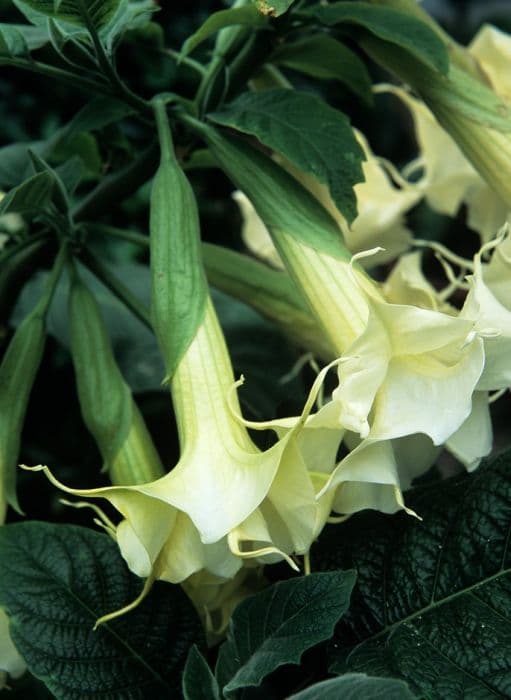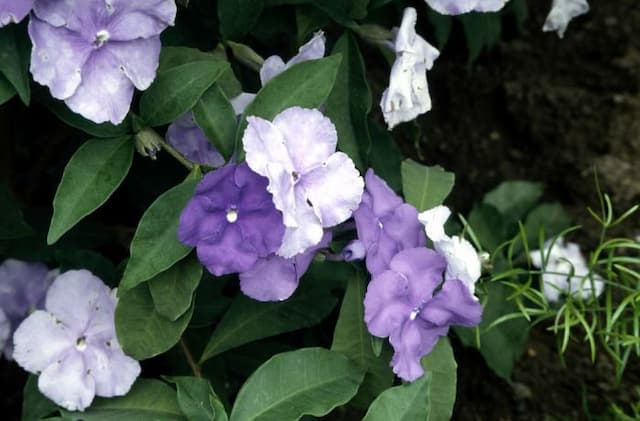Cape Gooseberry Physalis peruviana (F)

ABOUT
Physalis peruviana, commonly known as Goldenberry, is a distinctive plant popular for its unique fruiting structures. The plant features heart-shaped, slightly hairy leaves that spread along the stems, giving a lush, green backdrop for its yellow flowers. These small, bell-shaped blooms develop into fruit encased in a papery husk, resembling a miniature Chinese lantern. The husk starts out light green and gradually turns into a delicate, straw color as it dries and the berry inside matures. The Goldenberry itself is a small, round fruit, typically a little smaller than a cherry tomato. It has a smooth, glossy skin that transforms from green to a warm, golden yellow or orange when ripe. The taste of the berry is a complex mix of sweet and tart, often described as reminiscent of pineapple, mango, or sometimes even a hint of tomato. Physalis peruviana is a remarkable plant not just for its delicious fruit but also for the striking contrast between its fruiting lanterns and the foliage. When in full bloom, it's an attractive bush that catches the eye, whether in a garden bed or as part of a mixed border. The fruits are not only loved by humans but also attract a variety of birds and insects, adding an extra layer of life to your garden.
About this plant
 Names
NamesFamily
Solanaceae
Synonyms
Cape Gooseberry, Goldenberry, Pichuberry, Peruvian Groundcherry, Inca Berry, Aztec Berry, Physalis, Peruvian Cherry, Poha Berry, Husk Cherry, Aguaymanto, Uchuva
Common names
Alkekengi pubescens Moench, Alkekengi verecundum Salisb., Boberella peruviana (L.) E.H.L.Krause, Physalis esculenta Salisb., Physalis latifolia Lam., Physalis peruviana var. edulis Sims, Physalis peruviana f. esculenta (Salisb.) Voss, Physalis peruviana var. pubescens (Moench) Dunal, Physalis pubescens (Moench) Schlecht., Physalis pubescens var. tomentosa Waterf, Physalis tomentosa Medik., Physalis turbinata Medik., Physalis utilis Brenner, Vesicaria peruviana G.Don.
 Toxicity
ToxicityTo humans
Cape Gooseberry (Physalis peruviana) is not commonly known for being toxic to humans when its fruit is ripe and consumed in normal food quantities. However, unripe fruit, leaves, and other plant parts contain solanine, which can be toxic if ingested in significant amounts. Symptoms of solanine poisoning from Cape Gooseberry can include nausea, vomiting, diarrhea, abdominal pain, and in severe cases, it can lead to neurological disorders like ataxia (loss of control over body movements) or respiratory problems.
To pets
Cape Gooseberry (Physalis peruviana) can be toxic to pets if they ingest unripe fruits, leaves, stems, or any other part of the plant other than the ripe fruit. The toxic compound is solanine, which can cause gastrointestinal distress such as vomiting and diarrhea. In more severe cases, solanine ingestion in pets can lead to symptoms such as lethargy, weakness, convulsions, and in extreme cases, even respiratory failure. Pet owners should prevent their animals from having access to Cape Gooseberry plants, especially the unripe fruits and other plant parts.
 Characteristics
CharacteristicsLife cycle
Perennials
Foliage type
Deciduous
Color of leaves
Green
Flower color
Yellow
Height
3 feet (0.91 meters)
Spread
3 feet (0.91 meters)
Plant type
Shrub
Hardiness zones
8
Native area
South America
Benefits
 General Benefits
General Benefits- Nutritional Value: Physalis peruviana, also known as Cape gooseberry, is high in vitamins A, C, and B-complex, as well as minerals like iron, phosphorus, and calcium.
- Dietary Fiber: The fruit is a good source of dietary fiber, which can aid in digestion and maintaining a healthy gut.
- Low Calorie: Cape gooseberries are relatively low in calories, making them a healthy snack option for those watching their weight.
- Antioxidant Content: They contain antioxidants such as polyphenols and carotenoids which are known to fight free radicals and reduce oxidative stress.
- Culinary Versatility: Cape gooseberries can be eaten fresh, dried, or used in a variety of recipes, including jams, desserts, sauces, and salads, offering a unique flavor and texture.
- Decorative Use: The distinctive papery husk of the fruit makes it an attractive garnish or decorative element in food presentation.
 Medical Properties
Medical Properties- Immunomodulatory effects: Studies suggest that Physalis peruviana has components that may stimulate the immune system.
- Anti-inflammatory properties: The plant contains compounds that can help reduce inflammation in the body.
- Antioxidant content: High levels of antioxidants in the fruit can protect against oxidative stress and may reduce the risk of chronic diseases.
- Diuretic action: It may promote the excretion of urine, which can help in the treatment of conditions like hypertension and edema.
- Antimicrobial activity: Extracts from Physalis peruviana have shown potential in inhibiting the growth of certain bacteria and fungi.
- Hepatoprotective properties: Some studies suggest potential liver-protective effects, which might be beneficial for liver health.
- Antihyperglycemic effects: The plant may have a role in helping to manage blood sugar levels, relevant to diabetes management.
- Chemopreventive potential: Compounds in Physalis peruviana have been studied for their potential to prevent or slow down the development of cancer.
 Air-purifying Qualities
Air-purifying QualitiesThis plant is not specifically known for air purifying qualities.
 Other Uses
Other Uses- Insect repellent: The leaves of the Cape gooseberry can be used in natural insecticidal preparations to ward off certain pests in the garden.
- Natural dye: The vibrant color of the fruit can be used as a natural dye for fabrics or culinary creations.
- Decorative purposes: Cape gooseberry's unique papery husks make them popular in floral arrangements and as table decorations.
- Fruit preserves: The berries are often turned into jams, jellies, and marmalades, which are used to add a sweet and tangy flavor to various dishes.
- Craft material: Dried husks of the Cape gooseberry can be used in arts and crafts, such as making lanterns or as part of collages and scrapbooking.
- Culinary garnish: The distinctive husks can be used as an elegant garnish for desserts and cocktails, adding an exotic touch.
- Piñata fillings: In some cultures, the dried and hollowed-out husks of Cape gooseberry can be filled with small treats and used in piñatas.
- Fish poison: In some traditional practices, certain parts of the plant are used to stun fish, making them easier to catch.
- Traditional games: Children sometimes use the hollow husks to play various traditional outdoor games.
- Plant companion: Cape gooseberry can be planted among other crops to attract beneficial insects that help in pollination as well as pest control.
Interesting Facts
 Feng Shui
Feng ShuiThe Cape Gooseberry is not used in Feng Shui practice.
 Zodiac Sign Compitability
Zodiac Sign CompitabilityThe Cape Gooseberry is not used in astrology practice.
 Plant Symbolism
Plant Symbolism- Protection: The cape gooseberry's outer husk resembles a paper lantern, symbolizing shelter and safety, hence representing protection of what is inside.
- Hidden Beauty: With its fruit enclosed in a papery husk, the cape gooseberry suggests that true beauty often lies beneath an unassuming exterior.
- Illumination and Enlightenment: The bright, lantern-like husk may symbolize light amidst darkness, guiding towards intellectual or spiritual insight.
- Longevity and Health: As a nutrient-rich fruit, cape gooseberries are often seen as a symbol of good health and long life.
 Water
WaterThe Golden Berry, or Cape Gooseberry, prefers a consistent watering schedule to keep the soil evenly moist but not waterlogged. Water the plant thoroughly when the top inch of the soil feels dry, which typically means once per week. It's important to adjust the frequency of watering depending on weather conditions, watering more often during hot, dry spells and less during cooler, rainy periods. An average of 1 to 1.5 gallons of water weekly should suffice for most plants, but large or potted specimens may require slightly more or less. Over-watering can lead to root rot, so ensure good drainage.
 Light
LightThe Golden Berry thrives in full sunlight, enjoying at least six to eight hours of direct sunlight each day. The best spot for these plants is in an area that receives ample morning light with some protection from the intense heat of the afternoon sun if you live in a particularly hot climate. They can also grow in light shade, but fruit production might be less prolific compared to plants in full sun.
 Temperature
TemperatureCape Gooseberries grow best in temperatures between 50°F and 85°F. They can tolerate a minimum temperature down to around 28°F for short periods but cannot withstand hard frosts and should be protected or brought indoors if temperatures dip below freezing. The ideal growing conditions for this plant include warm days and cooler nights for optimal fruit development.
 Pruning
PruningPruning Cape Gooseberries is done to encourage bushier growth and improve air circulation within the plant. It is best to prune early in the growing season, removing any dead or damaged branches and thinning the center of the plant to allow light to reach the inner leaves. Pruning should be done sparingly, and you may also prune lightly after fruiting to prepare the plant for the next season's growth.
 Cleaning
CleaningAs needed
 Soil
SoilCape Gooseberry thrives in a well-draining soil mix with a pH between 6.0 and 7.5. Amend garden soil with compost and sand to improve drainage, or use a mix of two parts potting soil, one part coarse sand, and one part peat for potted plants.
 Repotting
RepottingCape Gooseberry should be repotted every one to two years or when the plant becomes root-bound. Choose a pot that’s slightly larger than the current one to allow for continued growth.
 Humidity & Misting
Humidity & MistingCape Gooseberry prefers moderate to low humidity levels and is quite tolerant of dry air, making it suitable for typical household conditions.
 Suitable locations
Suitable locationsIndoor
Cape Gooseberry needs bright light and limited water indoors.
Outdoor
Plant Cape Gooseberry in sunny spot, water regularly.
Hardiness zone
8-11 USDA
 Life cycle
Life cycleThe life cycle of Physalis peruviana, commonly known as Cape Gooseberry, begins with seed germination, which typically occurs in warm, moist soil conditions. After germination, the seedling develops a root system and a shoot that grows into a mature plant with characteristic heart-shaped leaves and a bushy structure. The plant then enters a vegetative state where it focuses on leaf and stem growth to establish a solid framework capable of supporting fruit production. Following the vegetative stage, the Cape Gooseberry produces small, bell-shaped flowers, usually yellow with a purple center, indicating the onset of the reproductive phase. After pollination, typically by insects, the flowers develop into small, spherical fruits encased in a paper-like husk, which turn from green to yellow or orange when ripe and contain many small seeds. The plant can then either be allowed to complete its annual cycle and perish after fruiting, or in perennial conditions, it can survive through multiple seasons, producing fruits annually.
 Propogation
PropogationPropogation time
Spring-Early Summer
The most popular way to propagate Cape Gooseberry is through seeds. The best time to sow seeds is in spring when the soil has warmed up to at least 50°F (10°C). Typically, seeds are planted in well-draining soil in a sunny spot and covered lightly with soil. Keeping the soil consistently moist is crucial for germination. Seedlings usually appear in 14 to 21 days. Once the seedlings have grown a few sets of true leaves and are strong enough, they can be transplanted outdoors following the last frost. Spacing the plants about 24 inches (60 centimeters) apart allows for adequate air circulation and room to grow.


![Calibrachoa [Callie Mango]](/_next/image?url=https%3A%2F%2Fplants-admin.emdemapps.com%2Fimages%2Fplants%2F%2Fimages%2F604b6514b1579.png&w=640&q=75)






